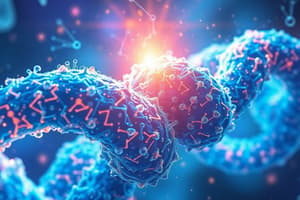Podcast
Questions and Answers
Which of these statements accurately describes the relationship between energy and chemical reactions?
Which of these statements accurately describes the relationship between energy and chemical reactions?
- Both exergonic and endergonic reactions release energy, but exergonic reactions release more.
- Exergonic reactions release energy, while endergonic reactions require an input of energy to occur. (correct)
- Both exergonic and endergonic reactions require an input of energy, but endergonic reactions require more.
- Exergonic reactions require an input of energy to occur, while endergonic reactions release energy.
What is the term for the measurement of disorder in a system?
What is the term for the measurement of disorder in a system?
- Enthalpy
- Kinetic energy
- Potential energy
- Entropy (correct)
What does the first law of thermodynamics state?
What does the first law of thermodynamics state?
- Energy can be transferred or transformed but not created or destroyed. (correct)
- Energy can be created or destroyed but not transferred or transformed.
- Energy can be created, destroyed, transferred, and transformed.
- Energy is always lost during energy conversions.
Which of the following is an example of potential energy?
Which of the following is an example of potential energy?
What is the relationship between the first and second laws of thermodynamics?
What is the relationship between the first and second laws of thermodynamics?
Which of the following processes is an example of an endergonic reaction?
Which of the following processes is an example of an endergonic reaction?
How do exergonic reactions differ from endergonic reactions?
How do exergonic reactions differ from endergonic reactions?
What is metabolism?
What is metabolism?
What is the key function of enzymes in biological reactions?
What is the key function of enzymes in biological reactions?
Which of the following is NOT a type of cellular work that ATP powers?
Which of the following is NOT a type of cellular work that ATP powers?
How does ATP drive endergonic reactions?
How does ATP drive endergonic reactions?
What is the role of the active site in an enzyme?
What is the role of the active site in an enzyme?
Which of the following is an example of a noncompetitive inhibitor?
Which of the following is an example of a noncompetitive inhibitor?
How does feedback inhibition regulate metabolic pathways?
How does feedback inhibition regulate metabolic pathways?
What is the significance of the activation energy barrier in chemical reactions?
What is the significance of the activation energy barrier in chemical reactions?
What is the main way that enzymes catalyze reactions?
What is the main way that enzymes catalyze reactions?
Which of the following is NOT a key difference between competitive and noncompetitive inhibitors?
Which of the following is NOT a key difference between competitive and noncompetitive inhibitors?
What is the role of phosphorylation in cellular work?
What is the role of phosphorylation in cellular work?
Flashcards
Energy
Energy
The capacity to cause change or perform work.
Kinetic Energy
Kinetic Energy
Energy of motion, present in moving objects.
Potential Energy
Potential Energy
Energy possessed due to position or structure.
Chemical Energy
Chemical Energy
Signup and view all the flashcards
First Law of Thermodynamics
First Law of Thermodynamics
Signup and view all the flashcards
Second Law of Thermodynamics
Second Law of Thermodynamics
Signup and view all the flashcards
Exergonic Reaction
Exergonic Reaction
Signup and view all the flashcards
Endergonic Reaction
Endergonic Reaction
Signup and view all the flashcards
Metabolic pathway
Metabolic pathway
Signup and view all the flashcards
Energy coupling
Energy coupling
Signup and view all the flashcards
ATP
ATP
Signup and view all the flashcards
Phosphorylation
Phosphorylation
Signup and view all the flashcards
Enzyme
Enzyme
Signup and view all the flashcards
Activation energy (EA)
Activation energy (EA)
Signup and view all the flashcards
Active site
Active site
Signup and view all the flashcards
Cofactors
Cofactors
Signup and view all the flashcards
Competitive inhibitor
Competitive inhibitor
Signup and view all the flashcards
Feedback inhibition
Feedback inhibition
Signup and view all the flashcards
Study Notes
Energy and the Cell
- Energy is the capacity to cause change or perform work. Two basic forms: kinetic (motion) and potential (location/structure).
- Chemical energy is potential energy stored in bonds.
- Thermodynamics studies energy transformations.
- The first law of thermodynamics (conservation) states energy cannot be created or destroyed, only transferred or transformed.
- Entropy is a measure of disorder.
- The second law of thermodynamics states energy conversions increase the entropy of the universe.
Chemical Reactions and Energy
- Chemical reactions either release or store energy.
- Exergonic reactions release energy; reactants have more energy than products. Example: Cellular respiration.
- Endergonic reactions absorb energy; products have more energy than reactants. Example: Photosynthesis.
- Metabolism is the total of an organism's chemical reactions, arranged as intersecting pathways.
- Metabolic pathways are series of reactions that construct or break down complex molecules.
- Energy coupling is the use of exergonic reactions to drive endergonic reactions.
ATP and Cellular Work
- ATP (adenosine triphosphate) powers cellular work.
- ATP becomes ADP through metabolic processes.
- ATP hydrolysis releases energy.
- Phosphorylation transfers a phosphate group from ATP to a molecule.
- Three main types of cellular work: chemical (forming molecules), mechanical (moving filaments), and transport (moving solutes). These all use ATP.
Enzymes and Chemical Reactions
- Activation energy is the energy needed for a reaction to start.
- Enzymes are biological catalysts, increasing reaction rates without being consumed.
- Most enzymes are proteins; some are RNA.
- Enzymes lower activation energy.
- The substrate is the specific reactant an enzyme acts on.
- The active site is the enzyme region where the substrate binds.
Enzyme Catalysis
- The catalytic cycle:
- Enzyme starts with an empty active site.
- Substrate binds (induced fit).
- Substrate converts to products.
- Enzyme releases products and emerges unchanged.
Enzyme Factors and Inhibitors
- Enzyme activity is affected by conditions (temperature, pH).
- Higher temperatures usually denature enzymes, affecting their shape and function.
- Optimal pH for most enzymes is near neutral (6-8). There are exceptions, like pepsin.
- Cofactors (inorganic or organic) bind to the active site and aid in catalysis.
- Inhibitors reduce enzyme productivity.
- Competitive inhibitors block the active site.
- Noncompetitive inhibitors bind to a different site, altering enzyme shape.
- Feedback inhibition is a mechanism for controlling enzyme activity using the reaction's end product.
Studying That Suits You
Use AI to generate personalized quizzes and flashcards to suit your learning preferences.




